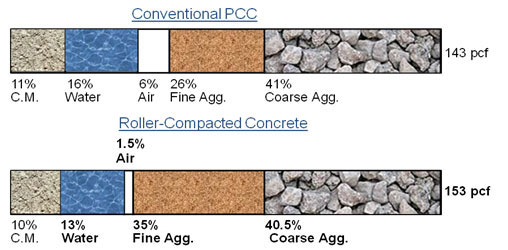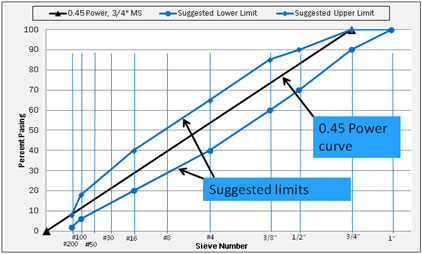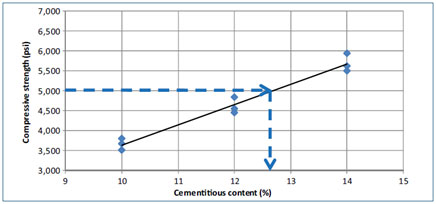Mix Design
Selection of proper materials and correct proportioning is critical to the production of quality Roller Compacted Concrete mixtures. The mixture design process should not use a trial and error approach, but rather a scientific and systematic approach that takes into account the desired engineering properties, construction requirements, and economics.

Graph courtesy of Portland Cement Association
A number of mixture proportioning methods have been successfully used throughout the world for Roller Compacted Concrete structures; therefore, it is difficult to identify one procedure as the standard procedure. However, the most common mixture proportioning methods are variations of the following two general approaches:
Concrete Consistency or workability method: A w/cm approach, with the consistency kept constant and the mixture determined by absolute volume
Soil Compaction method: A cement-aggregate approach, with the mixture determined by optimum moisture content and maximum dry density
Whichever method is used, the goal is to produce an Roller Compacted Concrete mixture that:
Has sufficient paste volume to coat the aggregates and fill the voids between them;
Is able to produce the required mechanical strength and elastic properties;
Has workability characteristics that make it easy to achieve required density; and
Is durable enough to endure in the given environment.
Concrete Consistency Method
The concrete consistency method normally requires the establishment of specific mixture parameters such as the amount of aggregates, the amount of water, or the amount of cementitious materials. One of these parameters is then adjusted in order to meet a required level of consistency, often measured using an apparatus called a Vebe consistometer. The consistency is measured as the time required for a given mass of concrete to be consolidated by external vibration in the Vebe apparatus cylindrical mold. This method has been used primarily for hydraulic structures.
Soil Compaction Method
The soil compaction method is the most widely used mixture proportioning method for Roller Compacted Concrete pavements. This proportioning method involves establishing a relationship between the density and moisture content of an Roller Compacted Concrete mixture to obtain the maximum density by compacting samples over a range of moisture contents.
The soil compaction method consists of the following steps:
1. Choose well-graded aggregates
The gradation of the combined aggregates should approach a maximum-density grading. The 0.45 Power curve is one method that can be used to define a dense gradation approaching the maximum density of any maximum size of aggregates.

Graph courtesy of Portland Cement Association
Generally, a gradation falling within the suggested band is desired to produce a product that can be compacted to near maximum density of the blended aggregates. It should be noted that the suggested band with a 3/4 in. (19mm) nominal maximum size provides gradation limits approaching the 0.45 Power curve for 3/4 in. (19 mm) maximum size. The 0.45 Power curve falls near the center of the band except for particles smaller than No.100 sieve.
2. Select a mid-range cementitious content
Choice of cementitious materials is based on the project specifications, economic considerations, availability of materials, and production considerations. For wearing course applications, a good starting point may be between 11 and 13 percent cement without the addition of CMs.
The cementitious materials are expressed as a percent of total dry materials. It is equal to the weight of cementitious materials divided by the total weight of cementitious materials plus weight of oven-dried aggregates, and the result is multiplied by 100.

3. Develop moisture-density relationship plots
For a fixed cementitious materials percentage, different moisture contents are selected to develop a moisture-density plot. The percent moisture content is equal to the weight of water divided by the total weight of cementitious materials plus weight of oven-dried aggregates, and the ratio is multiplied by 100.

For most aggregates, the optimum moisture content is found to be within the range of 5 to 8 percent.
It is suggested that the moisture content be varied within this range.

4. Cast samples to measure compressive strength
For each cementitious content, compressive strength specimens are made using the vibrating hammer (ASTM C1435) or the vibrating table method (ASTM C1176). All specimens should be molded at the optimum moisture content corresponding to the cementitious content of the mix.
5. Test specimens and select required cementitious content
The specimens are tested to determine the compressive strength at the selected cementitious contents. The data are plotted and a compressive strength versus cementitious content curve is developed, as shown here. From the curve, a cementitious content can be selected to meet the required strength. The required strength, f ’cr, should be equal to the specified strength, f ’c, plus a strength safety factor.

6. Calculate mixture proportions
After final selection of the cementitious content and optimum moisture content, the final mix proportions can be calculated for the project. Saturated surface-dry (SSD) condition of the aggregates should be used when determining the weight and corresponding volume calculations.
If the required cementitious content is significantly different from all cementitious contents used during testing, another moisture-density relationship test may be needed to determine the optimum moisture content at the required cementitious content. It is also reasonable to estimate this optimum moisture content by interpolation if the percent optimum moisture content did not vary significantly over the cementitious content range used during testing.


